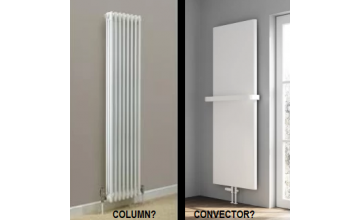When comparing the efficiency of column radiators with panel convector radiators, there are several key factors to consider, including heat output, energy consumption, installation requirements, and overall performance in various settings.
Efficiency and Heat Output
Column Radiators: Column radiators are known for their ability to produce both radiant and convective heat. Radiant heat directly warms objects and people in the room, providing a sense of warmth even if the air temperature is slightly lower. This type of heating can be more comfortable and is often perceived as warmer than convective heating. However, column radiators typically need to be larger to produce the same amount of heat as their panel convector counterparts. They are often chosen for their aesthetic appeal and ability to retain heat longer due to their mass and design.
Panel Convector Radiators:
Panel convector radiators, such as Type 21 (P+) and Type 22 (K2) models, are highly efficient in terms of heat output per unit of size. They operate primarily through convective heating, where air is drawn through fins that are heated by water flowing through the panels. This method quickly and evenly warms a room. Type 22 radiators, in particular, with two panels and two layers of convector fins, offer a high heat output while maintaining a relatively slim profile. This makes them suitable for rooms where space is a consideration.
Energy Consumption
Column Radiators: While aesthetically pleasing and capable of producing comfortable, long-lasting heat, column radiators generally consume more energy to reach the desired temperature compared to panel convectors. This is due to their larger surface area and the time it takes to heat the entire structure. However, once heated, they retain warmth longer, potentially reducing the frequency of reheating cycles.
Panel Convector Radiators: Panel convector radiators are more energy-efficient during the initial heating phase. Their design allows for rapid heat-up times and effective use of energy to heat a room quickly. The convector fins enhance the surface area for heat exchange, ensuring that more of the heat generated by the hot water is transferred to the air in the room. This can result in lower energy consumption over time, especially in environments where quick and efficient heating is required .
Installation and Maintenance
Column Radiators: Column radiators are heavier and bulkier, which can make installation more challenging, especially on stud walls or where existing pipework needs significant adjustment. They also require more robust mounting systems to ensure they are securely fixed. Maintenance involves regular bleeding to remove air pockets and occasional cleaning of the larger surface area to ensure efficient heat transfer.
Panel Convector Radiators: These radiators are generally easier to install due to their lighter weight and slimmer profile. They are often compatible with standard radiator valves and fittings, making replacements straightforward. Maintenance is similar to column radiators but typically involves less frequent bleeding and easier cleaning due to the smaller surface area and streamlined design .
Cost Considerations
Column Radiators: The initial cost of column radiators can be higher, especially for designer models. Their larger size and higher material costs contribute to this. However, their durability and the ability to provide long-lasting heat can offset some of these costs over time. The aesthetic value can also add to the property’s appeal, potentially increasing its overall value.
Panel Convector Radiators: These tend to be more affordable upfront due to their simpler design and lower material costs. The efficient heat output and lower energy consumption can result in lower operating costs over time. For homeowners looking for a cost-effective solution with good performance, panel convector radiators are often the preferred choice.
Summary
Column Radiators:
- Advantages:
- Provides comfortable radiant heat.
- Aesthetic appeal and design flexibility.
- Long heat retention.
- Disadvantages:
- Larger and heavier, making installation more complex.
- Higher initial cost and potentially higher energy consumption.
Panel Convector Radiators:
- Advantages:
- Efficient and quick heating due to convector fins.
- Lower energy consumption during initial heat-up.
- Easier and cheaper to install.
- Disadvantages:
- Primarily relies on convective heating, which may be less comfortable for some.
- Less aesthetically pleasing compared to column radiators.
Ultimately, the choice between column and panel convector radiators depends on the specific needs of the space, budget constraints, and personal preferences regarding design and comfort. For environments where quick, efficient heating is crucial, panel convectors are likely the better option. However, for those prioritising aesthetic appeal and the comfort of radiant heat, column radiators are an excellent choice.

